Author
I'm not entirely sure how this all happened.
Playing Beyond the Notes: A Pianist Guide to Musical Interpretation (Oxford University Press, 2013)
Playing Beyond the Notes demystifies the complex concepts of musical interpretation in Western tonal piano music by boiling it down to basic principles in an accessible writing style. Author and veteran piano instructor Deborah Rambo Sinn tackles a different interpretive principle, explaining clearly, for example, how to play effective ornaments and rubatos. As a whole, the book helps pianists understand concrete ways to apply interpretive concepts to their own playing and gives teachers practical ways to teach interpretation to their students. The book is illustrated with over 200 repertoire excerpts and supplemented by a companion website with over 100 audio recordings. Playing Beyond the Notes is essential reading for all performing pianists, independent piano teachers, and piano pedagogy students. Since its publication in 2013, universities across the US have adopted Playing Beyond the Notes as a textbook for their piano pedagogy courses, including Penn State University, Cincinnati College-Conservatory of Music, and Oklahoma University. hi def book cover

Reviews
"I find the book by Deborah Rambo Sinn a most valuable addition to the library of a performer, teacher, and music lover. It is in my opinion a must for any music shelf." --Menahem Pressler, Distinguished Professor of Music, Indiana University, pianist of Beaux-Arts Trio, and soloist
"Deborah has written an amazingly thorough compendium of the pianist's interpretive dilemmas. With precision, insight, and a strong dash of unique humor, she has addressed complex issues in a highly understandable way - providing an excellent resource for performers, teachers, and students!" --Timothy Shafer, Professor of Piano, Penn State University
"A useful and intelligently written book and seems to represent years of accumulated teaching wisdom. Sinn is tireless in the pursuit of solving passages unto the last sixteenth note, and often refreshingly precise in her explanations...Will allow teachers and students to think analytically about common interpretive situations at the piano." --College Music Symposium
"A perfect resource book (aka tool) for the studio teacher or for teen and adult students. It is written clearly, without either pretension or condescension and with detail but not great length...You can find a specific piece of advice or answer to a question, or, you can immerse yourself and read the entire book from cover to cover. Since it is intended as a textbook, it is perfect for studio group lessons as well...This book is a keeper!" --PianoAddict.com
Pocket Piano Proficiency: A revolutionary way to learn the skills you need

Pocket Piano Proficiency: a revolutionary way to learn the skills you need offers basic piano skills in a new way. Author and veteran piano instructor Deborah Rambo Sinn wanted to find a solution for getting students to learn these solidly and efficiently–along with finding a way to combine this with developing excellent aural skills. Ultimately, she sought a way to quickly make these skills relevant to understanding larger concepts of music theory.
Traditionally, it takes a long time of learning individual skills before a student can grasp how they all work together. Pocket Piano Proficiency flips this model, introducing tasks in chunks of like material. The circle of fifths appears from the first pages, demonstrating connections between keys from the start. The book’s pedagogical organization moves students from the easiest to more complex skills, allowing them to scaffold successfully from one chapter to the next.
The eBook format allows for a new way of learning these skills that a black and white printed book does not afford. Each page contains several layers of helpful material that can be accessed by zooming in and out. Because only one level of information can be accessed at a time, students need to assimilate information from around the page to successfully complete each task (see video.) Additionally, the use of color cues for tasks further organizes each chapter. As an example, red is used for the simplest keys or most common concepts.
Additionally, the use of color cues for tasks further organizes each chapter. As an example, red is used for the simplest keys or most common concepts.